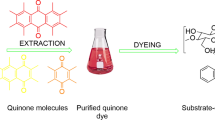Abstract
Symplocos spicata (local name: Dom sheng) belonging to Family Symplococeae produces yellowish brown natural dye which has been used for dyeing textiles since ancient times by the Monpas tribe of Arunachal Pradesh. Symplocos spicata (Dom Sheng) was found in the Lumla area of Tawang district. Leaves of the plant are used by the Monpas and Tibetans for extraction of dye. Innovative sonicator dyeing with S. spicata showed that pretreatment with 2–4% metal mordant of the weight of the fabric is optimum showing very good fastness properties for dyed natural polymers such as cotton, wool, and silk. CIELab and K/S of the dyed fabrics were also evaluated. The superiority of sonicator dyeing over conventional dyeing has been established through this study.
Similar content being viewed by others
References
D. Mahanta and S. C. Tiwari, Curr. Sci. India, 88(9), 1474 (2005).
R. D. Tiwari and H. L. Tripathi, Phytochemistry, 15(5), 833 (1976).
R. Higuchi, T. Kawasaki, M. Biswas, V. B. Pandey, and B. Dasgupta, Phytochemistry, 21(4), 907 (1982).
E. R. Trotman, “Dyeing and Chemical Technology of Textile Figures”, 6th Ed., New York, John Wiley and Sons, 1984.
B. Ghorpade, M. Darvekar, and P. S. Vankar, Colourage, 1, 27 (2000).
P. S. Vankar, V. Tiwari, and B. Ghorpade, Can. Text. J., 11/12, 31 (2001).
P. S. Vankar, R. Shanker, and J. Srivastava, Dyes Pigm., 72(1), 33 (2007).
R. Shanker, A. Verma, and P. S. Vankar, Journal of Cleaner Production, 15(15), 1441 (2007).
Indian Standards Institution(BIS), “Handbook of Textile Testing”, Manak Bhawan, p.539, p.550, p.553, p.569, New Delhi, 1982.
P. Kubelka, J. Opt. Soc. Am., 38(5), 448 (1948).
P. Kubelka, J. Opt. Soc. Am., 44(4), 330 (1954).
M. M. Kamel, R. M. El-Shishtawy, M. Youssef, and H. Mashaly, Dyes Pigm., 73(3), 279 (2007).
R. M. El-Shishtawy, M. M. Kamel, H. L. Hanna, and N. S. E. Ahmed, Polym. Int., 52(3), 381 (2003).
M. M. Kamel, R. M. El-Shishtawy, B. M. Youssef, and H. Mashaly, Dyes Pigm., 65, 103 (2005).
A. Johnson, “The Theory of Colouration of Textiles”, The Society of Dyers and Colourists, Chapter 4, Bradford, 1989.
Author information
Authors and Affiliations
Corresponding author
Rights and permissions
About this article
Cite this article
Vankar, P.S., Shanker, R., Dixit, S. et al. Sonicator dyeing of natural polymers with Symplocos spicata by metal chelation. Fibers Polym 9, 121–127 (2008). https://doi.org/10.1007/s12221-008-0020-6
Received:
Revised:
Accepted:
Published:
Issue Date:
DOI: https://doi.org/10.1007/s12221-008-0020-6




